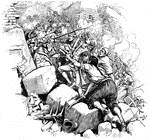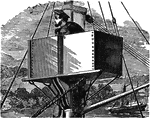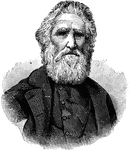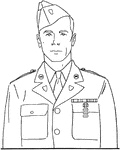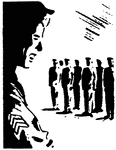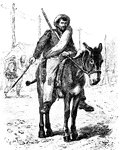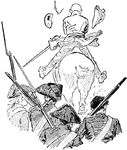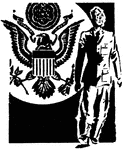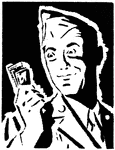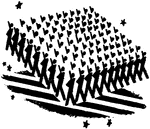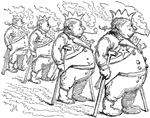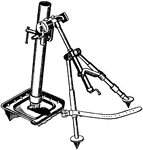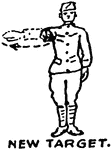Load
"At the command load each front-rank man or skirmisher faces half right and carries the right foot to…

Load
"Takes a loaded clip and inserts the end in the slip slots, places the thumb on the powder space of…

Load
"Each rear rank moves to the right foot, takes a similar position opposite the interval to the right…

Lunge
"Executed in the same manner as the thrust, except that the left foot is carried forward about twice…
Lying Down
"If lying down, the left hand steadies and supports the piece at the balance, the toe of the butt resting…

Military Man Walking with Briefcase
An illustration of a military man walking while holding a briefcase.

Map measurer
"By use of an instrument called a map measurer, set the hand on the face to read zero, roll the small…

Military Personnel Marching to the Right
An illustration of military personnel marching straight with the right side of the image illustrating…

Bust of Mark Antony
Marcus Antonius, known in English as Mark Antony, was a Roman politician and General. He was an important…
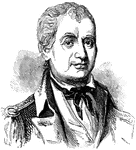
Lachlan McIntosh
Lachlan McIntosh (March 17, 1725 – February 20, 1806) was an American military and political leader…

Military Costume
"The military camail, again, the representative of the mail-coif of earlier times, found a parallel…
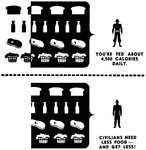
Military Meals Compared to Civilian
An illustration of military meals compared to that of civilian meals.

Military Tattoo
The original meaning of military tattoo is a military drum performance, but nowadays it sometimes means…
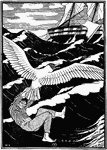
Baron Munchausen
This is an illustration of one of the stories of Baron Munchausen by artist William Strang. He was a…

Baron Munchausen
This is an illustration of one of the stories of Baron Munchausen by artist William Strang. He was a…

Normal Military Interval Measurement
An illustration of military personnel measuring normal intervals.

Palisade
"Palisades should be planted to incline slightly to the front. As little earth should be disturbed in…
Parade Rest
"Carry the right foot 6 inches straight to the rear, left knee slightly bent; clasp the hands, without…
Parade Rest with Rifle
"Carry the right foot 6 inches straight to the rear, left knee slightly bent; carry the muzzle in front…

High Parry
"Raise the rifle with both hands high enough to clear the line of vision, barrel downward, point of…

Low Parry
"Carry the point of the bayonet down until it is at the height of the knee, moving the point of the…

Low Parry
"These parries are rarely used, as an attack below the waist leaves the head and body exposed." —…
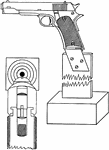
Pistol sighting rest
"To construct a sighting rest for the pistol take a piece of wood about ten inches long, one and a quarter…
Present Arms
"With the right hand carry the piece in front of the center of the body, barrel to the rear and vertical,…

Quick Time
The signal to march at the faster pace of 'quick time.' The Royal Navy marches at a cadence of 116 paces…

Range or Change Elevation
"To announce range, extend the arm towar the leaders or men for whom the signal is intended, fist closed;…
Rifle Salute
"Carry the left hand smartly to the small of the stock, forearm horizontal, palm of hand down, thumb…
Rifle Salute
"Carry the left hand smartly to the right side, palm of the hand down, thumb and fingers extended and…

